- ¿Qué es un parque nacional?
-
- Mar de las Calmas (propuesta)
- Aigüestortes i Estany de Sant Maurici
- Cabrera Archipelago
- Cabañeros
- Caldera de Taburiente
- Doñana
- Garajonay
- Atlantic Islands of Galicia
- Monfragüe
- Ordesa y Monte Perdido
- Picos de Europa
- Sierra de Guadarrama
- Sierra de las Nieves
- Sierra Nevada
- Tablas de Daimiel
- Teide
- Timanfaya
- La Red de un vistazo
- ¿Cómo funciona La Red?
- Cartography
- Central Booking
Transectos: Tajo del Halcón
Transectos: Tajo del Halcón
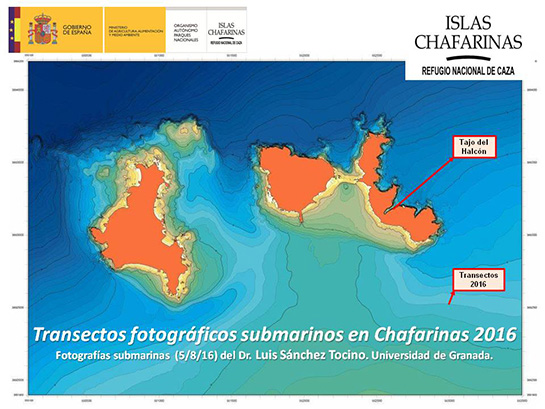 Resumen de las observaciones realizadas en cada metro de profundidad en Tajo del Halcón (Chafarinas). Autor: Luis Sánchez Tocino. Universidad de Granada
Resumen de las observaciones realizadas en cada metro de profundidad en Tajo del Halcón (Chafarinas). Autor: Luis Sánchez Tocino. Universidad de Granada
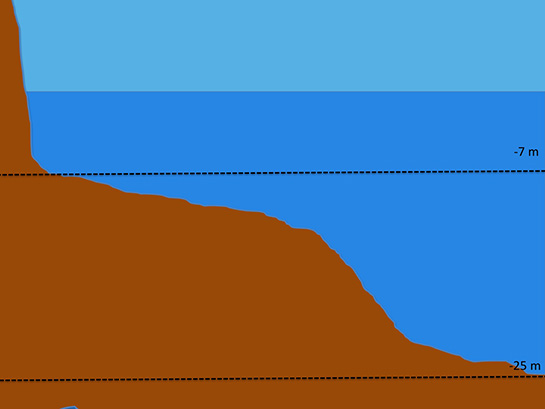 Representación del relieve del terreno en Tajo del Halcón
Representación del relieve del terreno en Tajo del Halcón
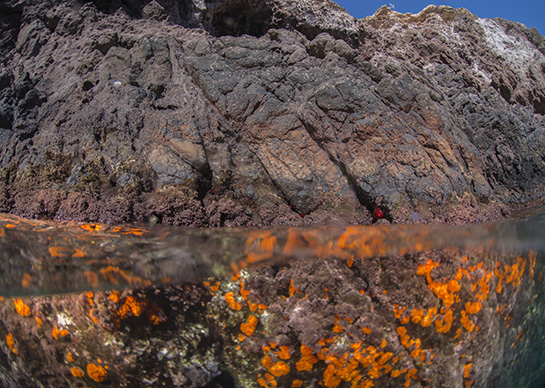 0m. El tomate de mar, Actinia equina, es una anémona típica del mediolitoral. En la fotografía se pueden ver varios ejemplares, en el interior de grietas buscando la umbría que estas le proporcionan, justo en el límite superior del cinturón del alga roja Corallina elongata.
0m. El tomate de mar, Actinia equina, es una anémona típica del mediolitoral. En la fotografía se pueden ver varios ejemplares, en el interior de grietas buscando la umbría que estas le proporcionan, justo en el límite superior del cinturón del alga roja Corallina elongata.
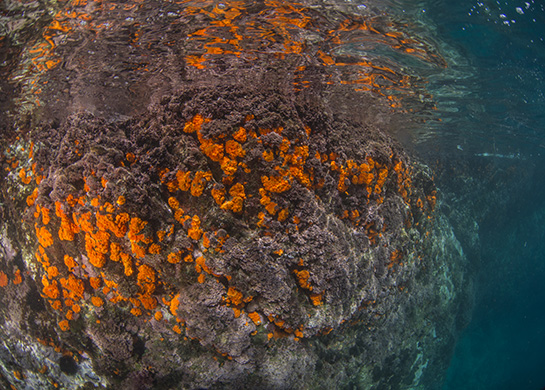 0m. En la imagen se aprecia como predominan el alga roja Corallina elongata y el coral naranja Astroides calycularis.
0m. En la imagen se aprecia como predominan el alga roja Corallina elongata y el coral naranja Astroides calycularis.
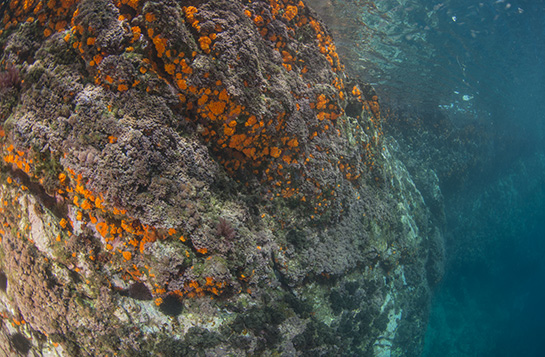 –1m. La umbría, debido a la orientación y a la altura de las paredes del Tajo, favorece la presencia del coral naranja, el cual compite por el sustrato con las algas rojas.
–1m. La umbría, debido a la orientación y a la altura de las paredes del Tajo, favorece la presencia del coral naranja, el cual compite por el sustrato con las algas rojas.
 –2m. Con el aumento de la profundidad aparecen los primeros ejemplares del alga parda Halopteris scoparia. En la parte inferior central se distingue, por su color verde, debido a la presencia de zooxantelas, una colonia del coral Oculina patagónica.
–2m. Con el aumento de la profundidad aparecen los primeros ejemplares del alga parda Halopteris scoparia. En la parte inferior central se distingue, por su color verde, debido a la presencia de zooxantelas, una colonia del coral Oculina patagónica.
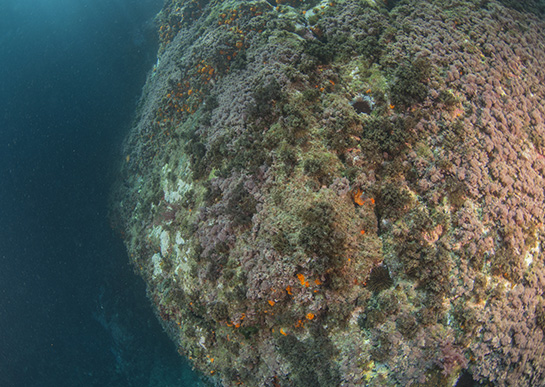 –3m. Las algas pardas y rojas desplazan al coral naranja a las grietas y extraplomos.
–3m. Las algas pardas y rojas desplazan al coral naranja a las grietas y extraplomos.
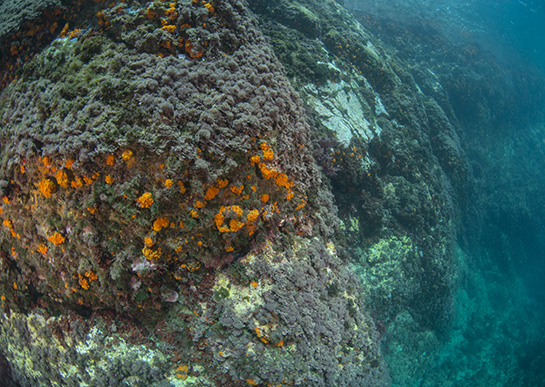 –4m. La presencia de un extraplomo, permite el asentamiento de algas rojas del género Peyssonnelia, junto al coral naranja, Astroides calycularis, y el alga verde, Flabellia petiolata.
–4m. La presencia de un extraplomo, permite el asentamiento de algas rojas del género Peyssonnelia, junto al coral naranja, Astroides calycularis, y el alga verde, Flabellia petiolata.
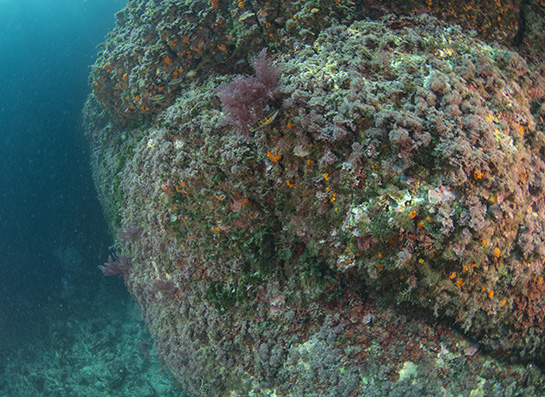 –5m. Un fredi o pez verde, Thalassoma pavo, nada por delante de un ejemplar del alga roja invasora Asparagopsis taxiformis.
–5m. Un fredi o pez verde, Thalassoma pavo, nada por delante de un ejemplar del alga roja invasora Asparagopsis taxiformis.
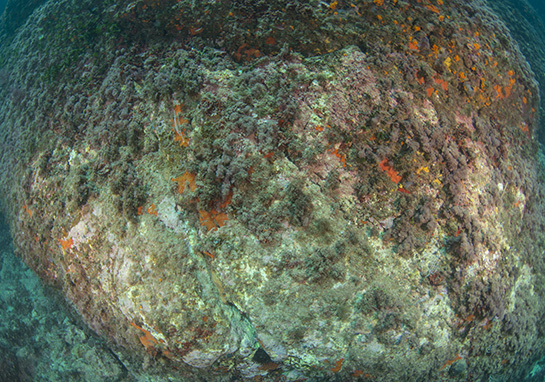 –6m. En la parte central de la imagen se puede observar una colonia de la gorgonia de color blanco Eunicella singularis.
–6m. En la parte central de la imagen se puede observar una colonia de la gorgonia de color blanco Eunicella singularis.
 –7m. El acantilado termina en un fondo en el que alternan bloques de piedra y afloramientos rocosos con grandes extensiones de arena.
–7m. El acantilado termina en un fondo en el que alternan bloques de piedra y afloramientos rocosos con grandes extensiones de arena.
 –8m. El alga roja Asparagopsis taxiformis crece en la parte superior de un gran bloque rocoso situado en la parte central del Tajo.
–8m. El alga roja Asparagopsis taxiformis crece en la parte superior de un gran bloque rocoso situado en la parte central del Tajo.
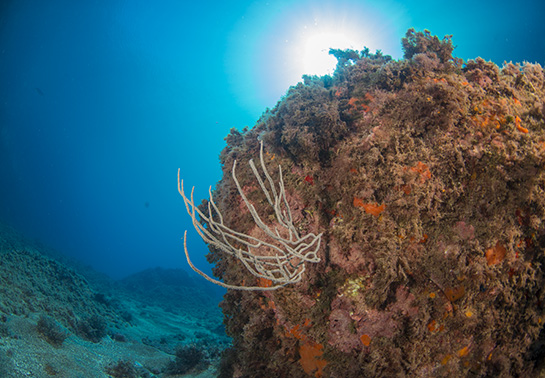 –9m. Algas y esponjas rojas junto a un ejemplar de la gorgonia Eunicella singularis se desarrollan aprovechando la umbría que le proporciona el gran bloque de piedra.
–9m. Algas y esponjas rojas junto a un ejemplar de la gorgonia Eunicella singularis se desarrollan aprovechando la umbría que le proporciona el gran bloque de piedra.
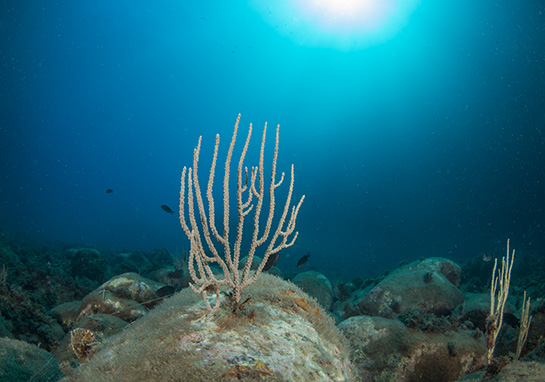 –10m. Sobre un pequeño bloque de piedra se asienta una gorgonia de la especie Eunicella singularis y justo por detrás nadan varias castañuelas Chromis chromis.
–10m. Sobre un pequeño bloque de piedra se asienta una gorgonia de la especie Eunicella singularis y justo por detrás nadan varias castañuelas Chromis chromis.
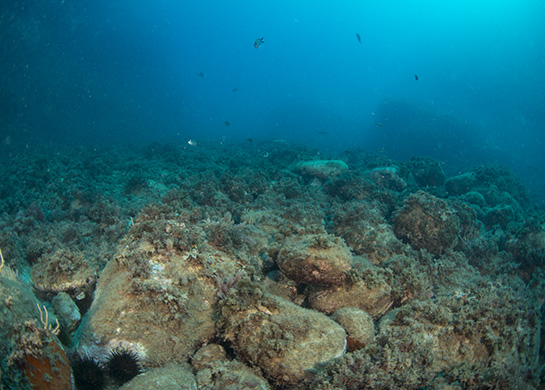 –11 m. El fondo, conforme nos aproximamos al exterior del tajo, se compone de pequeños bloques de piedra cubiertos por diferentes especies de algas e invertebrados.
–11 m. El fondo, conforme nos aproximamos al exterior del tajo, se compone de pequeños bloques de piedra cubiertos por diferentes especies de algas e invertebrados.
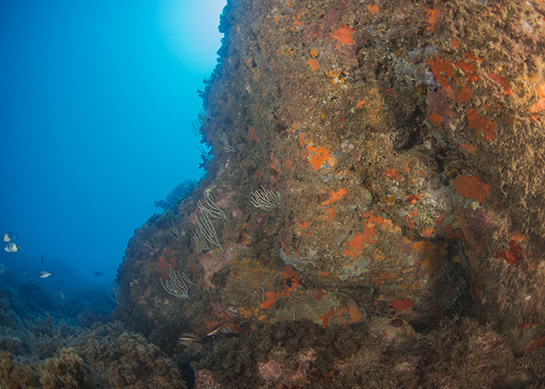 –12m. El aumento de la profundidad junto a la umbría de este extraplomo favorecen el crecimiento de las colonias de Eunicella singularis y de las esponjas rojas.
–12m. El aumento de la profundidad junto a la umbría de este extraplomo favorecen el crecimiento de las colonias de Eunicella singularis y de las esponjas rojas.
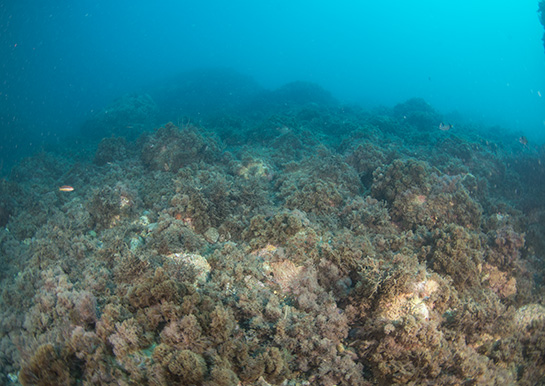 –13m. El alga parda Halopteris scoparia predomina a esta profundidad en el Tajo.
–13m. El alga parda Halopteris scoparia predomina a esta profundidad en el Tajo.
 –14m. Castañuelas, Chromis chromis, nadan sobre un fondo dominado por el alga parda Halopteris scoparia.
–14m. Castañuelas, Chromis chromis, nadan sobre un fondo dominado por el alga parda Halopteris scoparia.
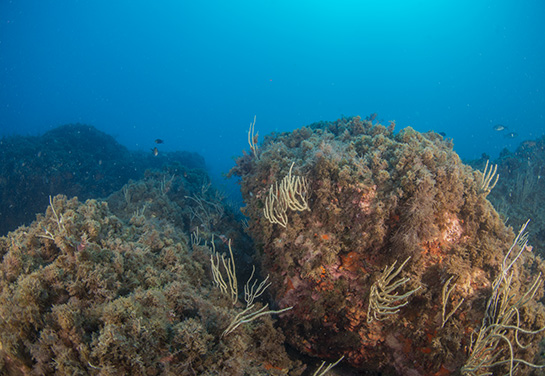 –15m. El aumento de la profundidad facilita a las gorgonias competir por el sustrato con las algas pardas.
–15m. El aumento de la profundidad facilita a las gorgonias competir por el sustrato con las algas pardas.
 –16m. Un juvenil de mero lobo Epinephelus canicus nada cerca de un erizo violáceo Sphaerechinus granularis con un penacho de algas sobre su cara aboral.
–16m. Un juvenil de mero lobo Epinephelus canicus nada cerca de un erizo violáceo Sphaerechinus granularis con un penacho de algas sobre su cara aboral.
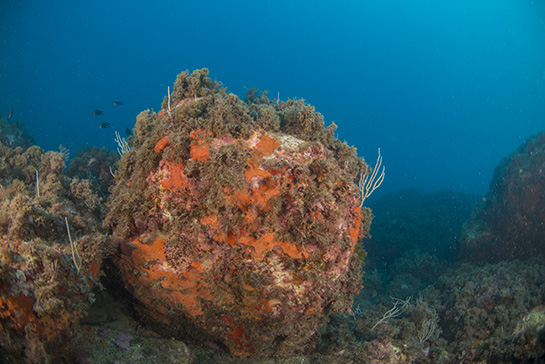 –17m. Entre las algas y las esponjas rojas se pueden observar algunas colonias del briozoo Myriapora truncata.
–17m. Entre las algas y las esponjas rojas se pueden observar algunas colonias del briozoo Myriapora truncata.
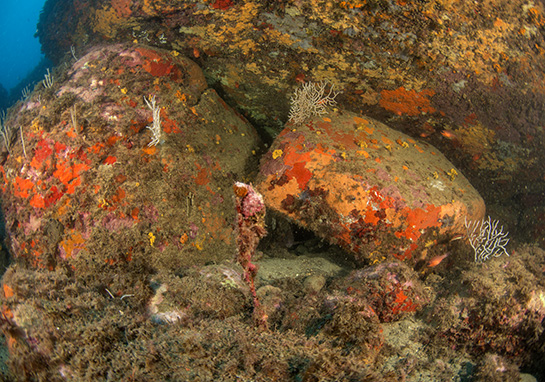 –18m. Los grandes bloques de piedra forman oquedades que permiten el asentamiento de una gran variedad de esponjas junto a tres colonias de la gorgonia Eunicella gazella. Se puede ver también algunos salmonetes reales Apogon imberbis y en primer término un fragmento, muerto y cubierto de epibiontes, de la gorgonia Elisella paraplexauroides.
–18m. Los grandes bloques de piedra forman oquedades que permiten el asentamiento de una gran variedad de esponjas junto a tres colonias de la gorgonia Eunicella gazella. Se puede ver también algunos salmonetes reales Apogon imberbis y en primer término un fragmento, muerto y cubierto de epibiontes, de la gorgonia Elisella paraplexauroides.
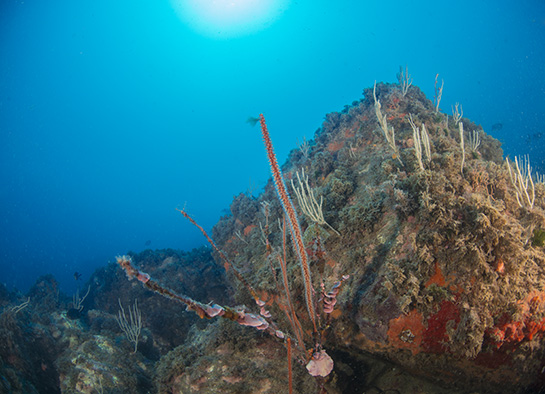 –19m. En primer término un ejemplar de Elisella paraplexauroides parcialmente cubierto de epibiontes. Otras gorgonias presentes en la imagen son Eunicella singularis y una pequeña colonia de Leptogorgia sarmentosa en la parte derecha de la misma.
–19m. En primer término un ejemplar de Elisella paraplexauroides parcialmente cubierto de epibiontes. Otras gorgonias presentes en la imagen son Eunicella singularis y una pequeña colonia de Leptogorgia sarmentosa en la parte derecha de la misma.
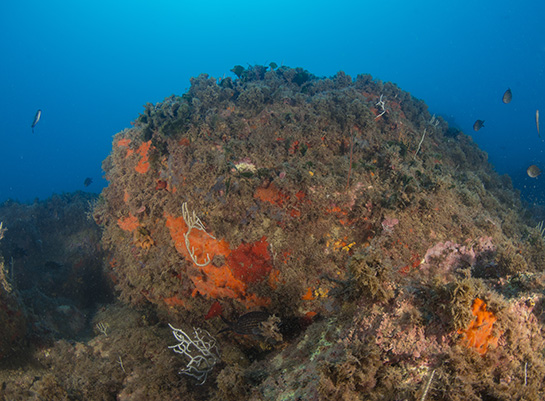 –20m. Sobre el bloque de piedra crecen tres especies de gorgonias: Eunicella singularis, Leptogorgia sarmentosa y Elisella paraplexauroides, y en la parte inferior del mismo Eunicella gazella. También es posible observar el briozoo Reteporella grimaldii o encaje de venus y dos ejemplares de la ascidia de color rojo Halocynthia papillosa.
–20m. Sobre el bloque de piedra crecen tres especies de gorgonias: Eunicella singularis, Leptogorgia sarmentosa y Elisella paraplexauroides, y en la parte inferior del mismo Eunicella gazella. También es posible observar el briozoo Reteporella grimaldii o encaje de venus y dos ejemplares de la ascidia de color rojo Halocynthia papillosa.
 –21m. Una castañuela nada sobre dos ejemplares de pequeño porte de Elisella paraplexauroides, uno de ellos parcialmente cubierto de epibiontes. En la parte izquierda un macho terminal de julia o doncella Coris julis.
–21m. Una castañuela nada sobre dos ejemplares de pequeño porte de Elisella paraplexauroides, uno de ellos parcialmente cubierto de epibiontes. En la parte izquierda un macho terminal de julia o doncella Coris julis.
 –22m. Una solitaria Elisella paraplexauroides tapa parcialmente a un grupo de mojarras Diplodus vulgaris.
–22m. Una solitaria Elisella paraplexauroides tapa parcialmente a un grupo de mojarras Diplodus vulgaris.
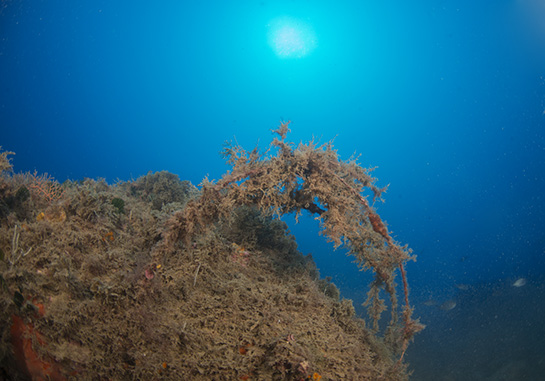 –23m. Una Elisella paraplexauroides muerta, yace doblada debido al peso de los organismos que cubren sus ramas.
–23m. Una Elisella paraplexauroides muerta, yace doblada debido al peso de los organismos que cubren sus ramas.
 –24m. Ejemplar de Paramuricea clavata, muy dañado en su base.
–24m. Ejemplar de Paramuricea clavata, muy dañado en su base.
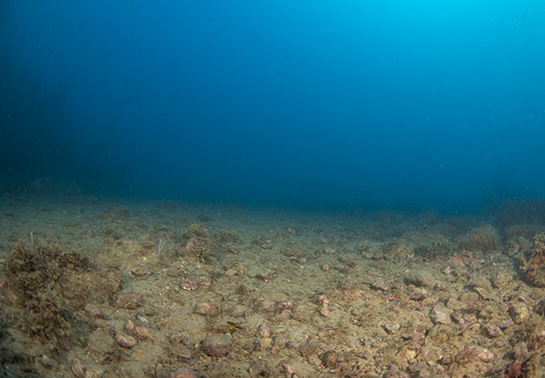 –25m. El fondo rocoso, a partir de esta profundidad, da paso a uno arenoso cubierto de pequeñas piedras.
–25m. El fondo rocoso, a partir de esta profundidad, da paso a uno arenoso cubierto de pequeñas piedras.
This page provides information on cookies we use: We use our own and third-party cookies to keep your session active, personalise your experience, and collect anonymous statistics about how you use this website. You can choose to accept all cookies or select which types you'd like to allow. To learn more about the cookies we use, read our Cookies Policy.
We use two types of cookies on this site. First, there are Functional Cookies, which are essential for the website to work properly. They store session data to make your experience smoother and more convenient. On the other hand, Analytical Cookies collect information about how you use the portal, without personal data, helping us provide a better and more tailored service.
Introduction to the Use of Cookies on the MITECO.gob.es Website
Cookies are small files that are stored on your device when you visit a webpage. They are essential tools that help provide many of the services available on the information society. Among other things, cookies allow a webpage to store and retrieve information about a user's browsing habits or their device. Based on this information, they can be used to recognise the user and enhance the service provided.
Types of Cookies
Depending on the entity that manages the domain from which the cookies are sent and processes the data, there are two types of cookies: first-party cookies and third-party cookies.
There is also a second classification based on how long the cookies remain stored in the user's browser: session cookies and persistent cookies.
Finally, cookies can also be classified into five types based on the purpose for which the data is processed: technical cookies, personalisation cookies, analytics cookies, advertising cookies, and behavioural advertising cookies.
For more information on this, you can refer to the Guide on the use of cookies from the Spanish Data Protection Agency.
Cookies used on the website
The web portal of the Ministry for Ecological Transition and the Demographic Challenge uses Adobe Analytics, an analytics tool that helps website and application owners understand how visitors interact with their content. Adobe Analytics uses a small number of cookies to collect data and generate usage statistics for websites. This information is sent anonymously and is not shared with third parties under any circumstances. You can choose to accept or reject these cookies, as they do not affect the portal’s functionality. However, they help provide valuable information that allows us to offer a better and more tailored service. For more information about Adobe Analytics cookies and privacy, please refer to the following links:
Additionally, pages featuring content from social network X will only set cookies if the user is logged into the X site. For more details on these cookies, please refer to the following link: Privacy on Social Network X
Finally, a technical cookie named MITECO-compliance is stored, which is a first-party, technical, and session-based cookie. It manages user consent for the use of cookies on the website, remembering which users have accepted them and which have not, ensuring that those who have accepted are not shown cookie consent messages at the top of the page. This cookie is essential for the proper functioning of the portal.
Cookies Policy Acceptance / Rejection
The Ministry for Ecological Transition and the Demographic Challenge gives you the option to accept or reject cookies that are not essential for the portal's operation. Upon accessing the portal, a message will be displayed in the centre of the page with information about the cookie policy and the following options:
· Firefox
· Chrome
· Safari